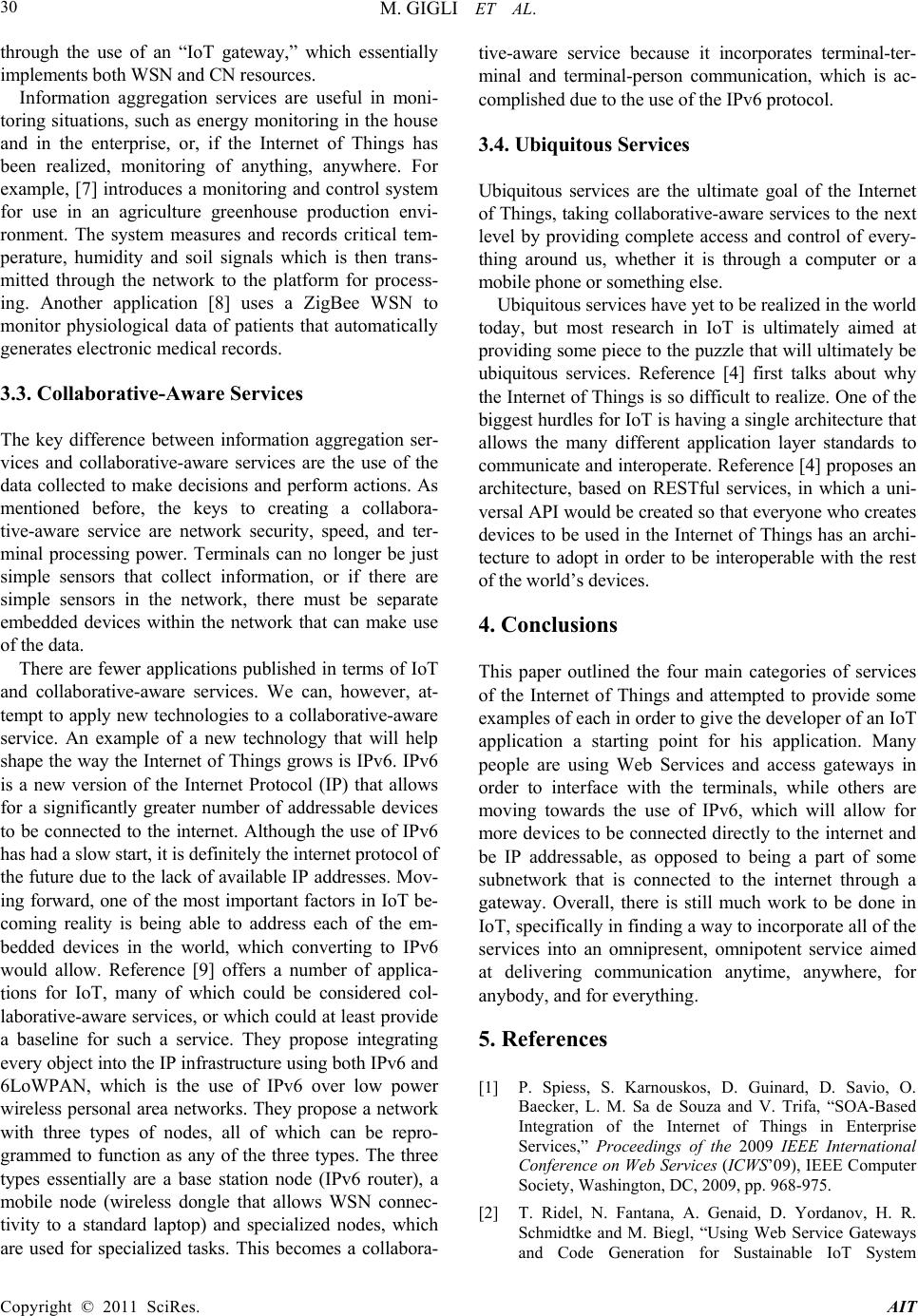
M. GIGLI ET AL.
Copyright © 2011 SciRes. AIT
30
through the use of an “IoT gateway,” which essentially
implement s both WSN an d CN resources.
Information aggregation services are useful in moni-
toring situations, such as energy monitoring in the house
and in the enterprise, or, if the Internet of Things has
been realized, monitoring of anything, anywhere. For
example, [7] introduces a monitoring and control system
for use in an agriculture greenhouse production envi-
ronment. The system measures and records critical tem-
perature, humidity and soil signals which is then trans-
mitted through the network to the platform for process-
ing. Another application [8] uses a ZigBee WSN to
monitor physiological data of patients that automatically
generates electronic medical records.
3.3. Collaborative-Aware Services
The key difference between information aggregation ser-
vices and collaborative-aware services are the use of the
data collected to make decisions and perform actions. As
mentioned before, the keys to creating a collabora-
tive-aware service are network security, speed, and ter-
minal processing power. Terminals can no longer be just
simple sensors that collect information, or if there are
simple sensors in the network, there must be separate
embedded devices within the network that can make use
of the data.
There are fewer applications published in terms of IoT
and collaborative-aware services. We can, however, at-
tempt to apply new technologies to a collaborative-aware
service. An example of a new technology that will help
shape the way the Internet of Things grows is IPv6. IPv6
is a new version of the Internet Protocol (IP) that allows
for a significantly greater number of addressable devices
to be connected to the internet. Although the use of IPv6
has had a slow start, it i s defini t ely the int ernet prot ocol of
the future due to the lack o f available IP addresses. Mov-
ing forward, one of the most important factors in IoT be-
coming reality is being able to address each of the em-
bedded devices in the world, which converting to IPv6
would allow. Reference [9] offers a number of applica-
tions for IoT, many of which could be considered col-
laborative-aware services, or which could at least provide
a baseline for such a service. They propose integrating
every object into th e IP infrastructu r e using both IPv6 an d
6LoWPAN, which is the use of IPv6 over low power
wireless personal area networks. They propose a network
with three types of nodes, all of which can be repro-
grammed to function as any of the three types. The three
types essentially are a base station node (IPv6 router), a
mobile node (wireless dongle that allows WSN connec-
tivity to a standard laptop) and specialized nodes, which
are used for specialized tasks. This becomes a collabora-
tive-aware service because it incorporates terminal-ter-
minal and terminal-person communication, which is ac-
complished due t o the use o f t he IP v6 protocol.
3.4. Ubiquitous Services
Ubiquitous services are the ultimate goal of the Internet
of Things, taking collaborative-aware services to the next
level by providing complete access and control of every-
thing around us, whether it is through a computer or a
mobile phone or something else.
Ubiquitous services h ave yet to be realized in th e world
today, but most research in IoT is ultimately aimed at
providing some piece to the puzzle that will ultimately be
ubiquitous services. Reference [4] first talks about why
the Internet of Things is so difficult to realiz e. One of the
biggest hurdles for IoT is having a single architecture that
allows the many different application layer standards to
communicate and interoperate. Reference [4] proposes an
architecture, based on RESTful services, in which a uni-
versal API would be created so that everyone who creates
devices to be used in the Internet of Things has an archi-
tecture to adopt in order to be interoperable with the rest
of the world’s devices.
4. Conclusions
This paper outlined the four main categories of services
of the Internet of Things and attempted to provide some
examples of each in order to give the developer of an IoT
application a starting point for his application. Many
people are using Web Services and access gateways in
order to interface with the terminals, while others are
moving towards the use of IPv6, which will allow for
more devices to be connected directly to the internet and
be IP addressable, as opposed to being a part of some
subnetwork that is connected to the internet through a
gateway. Overall, there is still much work to be done in
IoT, specifically in finding a way to incorporate all o f the
services into an omnipresent, omnipotent service aimed
at delivering communication anytime, anywhere, for
anybody, and for everything.
5. References
[1] P. Spiess, S. Karnouskos, D. Guinard, D. Savio, O.
Baecker, L. M. Sa de Souza and V. Trifa, “SOA-Based
Integration of the Internet of Things in Enterprise
Services,” Proceedings of the 2009 IEEE International
Conference on Web Services (ICWS’09), IEEE Computer
Society, Washington, DC, 2009, pp. 968-975.
[2] T. Ridel, N. Fantana, A. Genaid, D. Yordanov, H. R.
Schmidtke and M. Biegl, “Using Web Service Gateways
and Code Generation for Sustainable IoT System